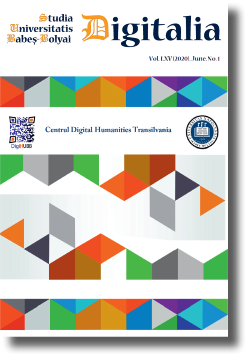DIGITAL AND CODING LITERACY FOR SCHOOL STUDENTS
DOI:
https://doi.org/10.24193/subbdigitalia.2018.1.04Keywords:
digital literacy, coding literacy, programming, gamification, ScratchAbstract
In the digitalization era, the notion of gamification appeared in every field of activity. Experimenting gamification of programming hours by practitioners and teachers in the 2017-2018 school year at the 5th grade is part of the research area related to identifying ways to improve student engagement and skills for lifelong learning.
The article will present the outcome of this pilot experiment, which aims to track the evolution of pupils during the project, by analyzing and comparing the results from the initial evaluation with those from the final evaluation. The purpose of the article is, on one hand, to contribute to the literature with new results in the field of digitization of the teaching-learning activities through gamification, and, on the other hand, to present a new teaching instrument used to streamline the instructive-educational process at the fifth grade students, within the Computer Science, which is now a mandatory object. The experiment was conducted in accordance with the Creative Computing curriculum created by the ScratchEd team at the Harvard Graduate School of Education.
References
Bazalgette, C., & Buckingham, D. (2013). Literacy, media and multimodality: A critical response. Literacy, 47(2), 95–102.
Bølgan, N. (2012). From IT to tablet: Current use and future needs in kindergartens. Nordic Journal of Digital Literacy, 7(3), 154–170.
Howard, M. L. (2013). Growing young minds: How museums and libraries create lifelong learners. Washington, DC: Institute of Museum and Library Services.
Bearne,E.(2009). Multimodality, literacy and texts: Developing a discourse. Journal of Early Childhood Literacy,9(2),156–187.
Dietze, B., & Kashin, D. (2013). Shifting views: Exploring the potential for technology integration in early childhood education programs. Canadian Journal of Learning and Technology, 39(4), 1–13.
Maclean, J. (2008). Library preschool storytimes: Developing early literacy skills in children. Library Preschool Storytimes. Retrieved from
https://ed.psu.edu/goodling-institute/judy-maclean-library-preschool-storytimes
McDonald, S., & Howell, J. (2012). Watching, creating and achieving: Creative technologies as a conduit for learning in the early years. British Journal of Educational Technology, 43, 641–651. doi: 10.1111/j.1467-8535.2011.01231.x McDougall, J. (2010). A crisis of professional identity: How primary teachers are coming to terms with changing views of literacy. Teaching and Teacher Education, 26, 679–687.
Campbell Claire, Walsh Chris (2017) Introducing the ‘new’ digital literacy of coding in the early years. Practical Literacy, 22 (3). pp. 10-12.
Fleer, M. (2013). Play in the early years. Port Melbourne, VIC: Cambridge.
Commonwealth of Australia. (2009). Belonging, Being, Becoming: The Early Years Framework for Australia. Canberra: Australian Government Department of Education, Employment and Workplace Relations for the Council of Australian Government. Retrieved from
Lankshear, C. & Knobel, M. (2003). New technologies in early childhood literacy research: A reviewofresearch. JournalofEarlyChildhood Literacy, 3(1),59–82.
Siegel,M.(2006).Rereading the Signs: Multimodal Transformations in the Field of Literacy Education, Language Arts,84(1),65–77.
Siegel, M., Kontovourki, S., Schmier, S., & Enriquez, G. (2008). Literacy in motion: A case study of a shape-shifting kindergartener. Language Arts, 86(2), 89–98.
Szmodis, W., & Columba, L. (2013). Technology for young learners: Making a case for innovative tools. National Teacher Education Journal, 6(1), 61–68.
Greer, L., and Heaney, P. J., 2004, Real-Time Analysis of Student Comprehension: An Assessment of Electronic Student Response Technology in an Introductory Earth Science Course: Journal of Geoscience Education, v. 52, p. 345-351.
McDonald, S., & Howell, J. (2012). Watching, creating and achieving: creative technologies as a conduit for learning in the early years. British Journal of Educational Technology, 43, 641–651
McDougall, J. (2010). A crisis of professional identity: How primary teachers are coming to terms with changing views of literacy. Teaching and Teacher Education, 26, 679–687
Downloads
Published
How to Cite
Issue
Section
License
Copyright (c) 2018 Studia Universitatis Babeș-Bolyai Digitalia

This work is licensed under a Creative Commons Attribution-NonCommercial-NoDerivatives 4.0 International License.


